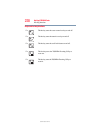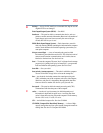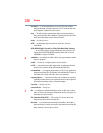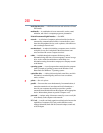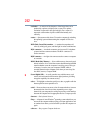
236
Glossary
download — (1) In communications, to receive a file from another
computer through a modem or network. (2) To send font data from
the computer to a printer. See also upload.
drag — To hold down the mouse button while moving the pointer to
drag a selected object. In the Windows
®
operating system, this refers
to the left mouse button, unless otherwise stated.
driver — See device driver.
DVD — An individual digital versatile (or video) disc. See also
DVD-ROM.
DVD-ROM (Digital Versatile [or Video] Disc Read-Only Memory)
— A very high-capacity storage medium that uses laser optics for
reading data. Each DVD-ROM can hold as much data as several
CD-ROMs. Compare CD-ROM.
E
emulation — A technique in which a device or program imitates another
device or program.
enable — To turn on a computer option. See also disable.
eSATA — An external device that supports hot swapping and fast data
transfer. Very useful in storing and transferring large files.
executable file — A computer program that is ready to run. Application
programs and batch files are examples of executable files. Names of
executable files usually end with a .bat or .exe extension.
expansion device — A device that connects to a computer to expand its
capabilities. Other names for an expansion device are port expander,
port replicator, docking station, or network adapter.
extension — See file extension.
external device — See device.
F
file — A collection of related information, saved on disk with a unique
name. A file may be a program, information used by a program, or a
document. See also document.
File Allocation Table (FAT) — The section of a storage drive that
keeps track of the location of stored files.
file name — A set of characters that uniquely identifies a file within a
particular folder. It consists of two parts: the actual name and the file
name extension. See also file extension.



